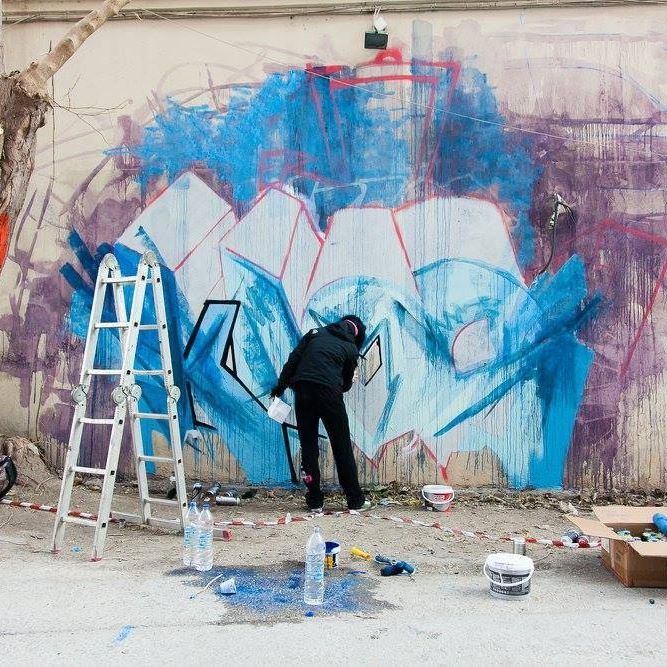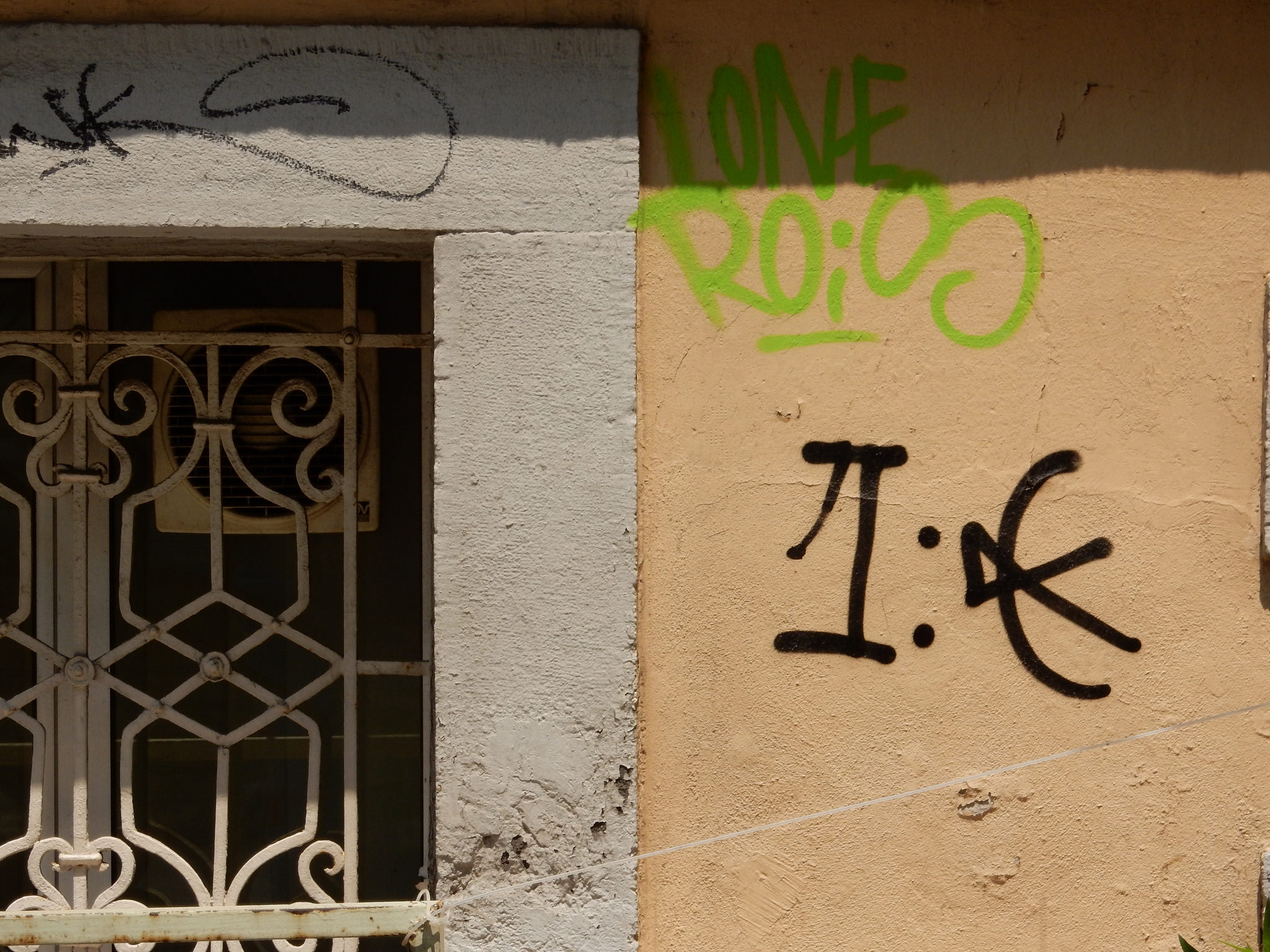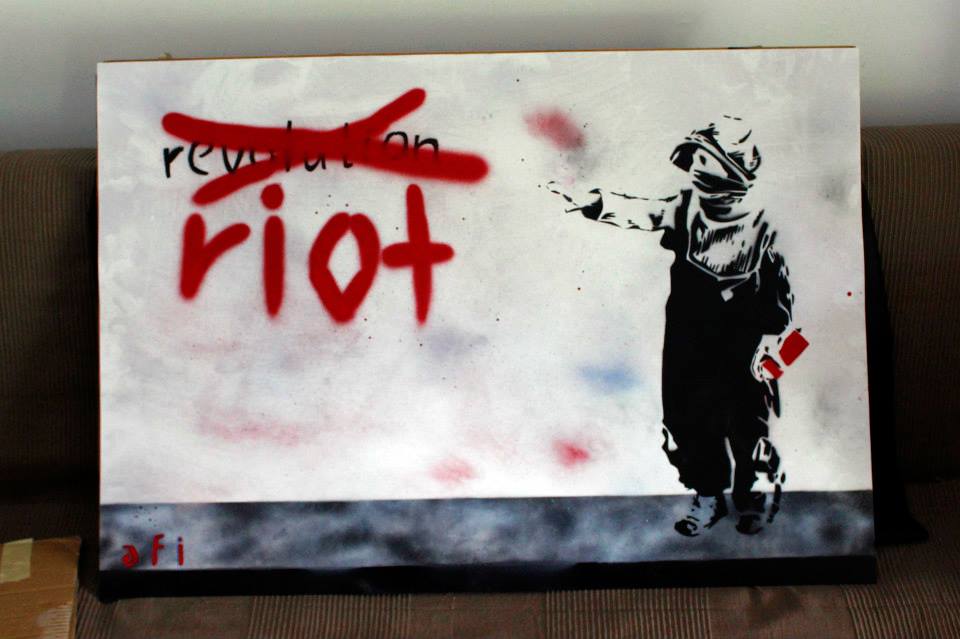Many political artists in Athens make use of stencils, but no one has perfected this art form like Mapet. He made his first attempt at a stencil in 2006 while living in Bristol, but these days he has an archive of about 200 motifs to chose from. The reason for this productivity boost is quite unique: when he is not out painting the streets Mapet is a dentist who at a certain point discovered that a dental wheel was the perfect tool for cutting stencils. In the short documentary the wake up call (where you can also see him work his equipment), he states that his motivation is “to produce counter information and counter propaganda against this enormous influence that is the media in Greece.” All of his stencils are political, many of them anti-fascist. He blogs about his work here.
How did you first start making stencils?
I just bought the books of Banksy, back when they first came out. And Banksy was from Bristol, so I had seen some of his work. Not stencils but this one very classic graffiti of the teddy bear throwing a molotov bomb at the police. I also always liked comics and used to draw and I had a dream to make a comic. But I was too lazy to make one because it takes lots of work. I saw the stencil and I said: this is easy, this is something I can do myself. So at the time I made the first two stencils with the help of a friend of mine who was a graphic designer.
What were they?
The first one, that I don’t have a copy of or a photo of was not very successful. It was a picture I had taken at a park in Bristol of a guy drinking cider from a big plastic bottle and his one year old son reaching up, trying to grab the cider. The second one was a portrait of my girlfriend at the time.

4 out of 200: the seagull says “no fascists no nationalists in our cities and villages,” the two kids say “poison the fascists,” the gun hand guy is out of the movie La Haine, the playmobil figurine is Mapets mascot.
Did you get right back to it after you came back to Greece?
No, I didn’t do anything new for a while. I used to take a lot of pictures of street art in Athens and places I travelled. So a friend of mine called me to ask how to make a stencil. I thought that if he is doing stencils then I also have to do it again. I started making them and I would have stopped. I was cutting with a scalpel and as a lazy guy I would have stopped but then I thought I could cut with a drill. And after that I must have produced the most stencils in Greece. I mean, I think I’m close to 200. I don’t think anybody else has cut so many stencils.
So when did it start to become political for you?
Almost from the beginning. Maybe my first ones were not so political, but from the beginning I started to make some anti-fascist ones. I still had the influence from living in England so I made one with Tony Blair taking a blow job.
How would you say you are influenced by the crisis as a political circumstance?
The crisis, as a brand name, was not yet in use when I started 2006-7. The crisis came out in 2008. The 2008 riots gave me a boost because at the time I participated in many squats, actions, assemblies and so in. I spent many hours of my time there so I had new ideas. I became more politicized and I produced more stuff. I also started to blog.
How do you decide where to place your stencils? Are there any specific parts of Athens you are particularly active in?
My advantage is that I make small stencils so if I have them with me I can be active anywhere. Mostly I’m active in the centre and around here, where I am mostly, but I’ve painted outside Athens, I’ve painted outside in Berlin, in Amsterdam, in Bulgaria, I will paint in Istanbul next month, hopefully.
Do you collaborate with other artists?
Yes, but randomly. I used to work a lot and be really good friends with the Political Zoo team but unfortunately all of them are living abroad at the moment and stopped doing stencils. About two or three months ago I was out for a beer and I had my stencils and I met Refur and EX!T painting and the girl made the body and I made the head. But usually I just have everything with me in my bag and I paint randomly and little pieces. I am lucky because I was admiring WD and I met him and we had a couple of exhibitions together, also at Stigma. I was admiring Fotis and i met him. Fors also, I like his stuff and I met him. It went like that with many other people, that I admired their work without knowing them, and now I know them.
Have you ever experimented with any other kinds of styles?
I’ve done a paste-up. A few years ago when I went to Syros there was this festival and I had to paint a big wall and I had two big stencils but it wasn’t easy to carry them, so I painted them on paper and then I pasted them.
When you look at political street artists in Athens, would you say their attitudes are similar or that there’s a big spectrum of ideas?
There is a big spectrum, yes. Let’s say I try to be pop, in a way that everybody can understand: my grandmother, the fascists, me, the anarchists, everybody. My purpose is for everybody to be able to understand what I do, that’s why I use very common symbols like this seagull that says no to fascism. This is written in every Greek’s mind because it was on television from the 80s until now. Generally I am a bit more with the anarchists, knowing they are not the best thing to have right now but also knowing that they are something that tries to react.
How do you decide which stencils to take with you when you go out? Do you have any kind of system for that?
No, it has become a problem nowadays, because I have too many. For example, a month ago, on valentine’s day, i took the valentines one. I usually have an anti-fascist one with me, because I have so many and because unfortunately they are up to date as we have a problem with the fascists. I always carry the latest ones to spread. It depends but it has become a problem.
Since you say that you’re associated with the anarchists, are you involved in assemblies and demonstrations frequently?
I go to demonstrations by myself and with my friends. I haven’t been to any assembly in the last two years. I was very active between 2008 and 2011 but lately not so much.
You said you’re a pessimist in The Wake Up Call, do you believe there’s anything that’s going to change for the better?
Today I was reading about nuclear war in Korea, how can you not be pessimist, we are in 2013 and we have the same problem as we had 50 years ago. Not only the same, but even worse. We have more weapons in our hands, like the internet, but I don’t see any good news. If you see something good, it comes and goes. And I’m not 20 years old, to believe in stuff now, I’m a bit older.
Did you use to believe that there are possibilities for political change?
I have believed in ideas and I believe in ideas, but I don’t see them happening. I don’t believe that something good will happen.
Is that why you stopped being active politically?
That’s one reason. Another reason is that I was tired. I told you anarchists are not perfect, and the assemblies are very boring. And we’ve had many defeats in the last years. I mean, we had this boost in 2008. We were—I was—optimistic then, but not optimistic for the future. I was optimistic because things were happening and it was so active and so nice. And everybody was like that then but then after a couple of years we faced the defeat.

Stencil made by Mapet in collaboration with Political Zoo and Iliana reflecting on a political action by immigrants who sewed their mouths shut in protest of their living conditions. Photo via http://mapetstencils.wordpress.com/
—
This interview was conducted in person on April, 4 2013.
Questions by Julia Tulke.









